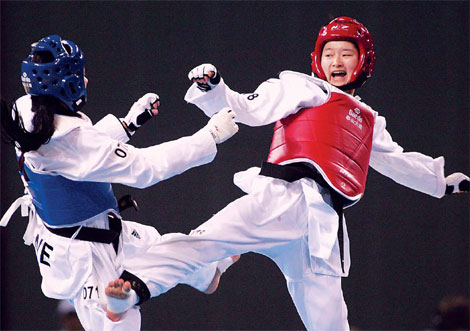Thousands of taekwondo fans from both sides of the Taiwan Straits are expected at the Beijing Science and Technology University Gymnasium today, when two of the best athletes appear on the opening day of competition.
Wu Jingyu from Jiangxi and Yang Shu-Chun from Chinese Taipei have been drawn in the same half of today's women's 49kg competition.
 Wu Jingyu of China (right) in the women's 49kg taekwondo finals at the "Good Luck Beijing" 2008 Taekwondo Tournament. [China Daily]
Wu Jingyu of China (right) in the women's 49kg taekwondo finals at the "Good Luck Beijing" 2008 Taekwondo Tournament. [China Daily] |
The two, both in their early 20s and superior exponents of their sport, will very likely face each other in the semifinals in what will be the third time in major competition in the past two years.
Taekwondo has gained popularity following the success of athletes from across the Straits at previous Olympics. Officials from both sides have stated they expect at least two gold medals from the sport.
Wu defeated Yang in a 3-0 victory in the semifinals of last year's World Championships in Beijing, before winning her first world title. But Yang took revenge in the final of the Asian Championships in May. Both athletes will enjoy the support of 8,000 home fans in the taekwondo venue, but Yang might be a slight favorite.
Her boyfriend, Chu Mu-Yen, will also compete at the same time in the men's 58 kg.
Chu, who brought Chinese Taipei its first Olympic gold in any sport, is on course to clash with world champion Juan Antonio Ramos of Spain in the semi-finals.
The couple will back each other up in today's competition and may write taekwondo history by winning two medals.
China's taekwondo chief, Zhao Lei, believes his players are both technically and mentally ready.
Cai Cijue, Chef de Mission for Chinese Taipei, said his athletes are familiar with Beijing and will enjoy some kind of advantage from that.
"We share the same language and living habits with the Chinese mainland, which will give us an advantage. We are very confident of doing a good job here," he told Xinhua. "We expect to clinch gold medals in taekwondo again."
Olympic taekwondo is limited to four men's and four women's divisions over four days, beginning with lighter divisions.
Each country or region can send a maximum of four fighters, two men and two women, a quota which was originally meant to keep South Korea from hogging the medals but which no longer seems necessary due to the sport's rapid global spread.